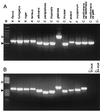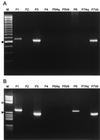Detection and identification of fungal pathogens by PCR and by ITS2 and 5.8S ribosomal DNA typing in ocular infections
- PMID: 11474006
- PMCID: PMC88253
- DOI: 10.1128/JCM.39.8.2873-2879.2001
Detection and identification of fungal pathogens by PCR and by ITS2 and 5.8S ribosomal DNA typing in ocular infections
Abstract
The goal of this study was to determine whether sequence analysis of internal transcribed spacer/5.8S ribosomal DNA (rDNA) can be used to detect fungal pathogens in patients with ocular infections (endophthalmitis and keratitis). Internal transcribed spacer 1 (ITS1) and ITS2 and 5.8S rDNA were amplified by PCR and seminested PCR to detect fungal DNA. Fifty strains of 12 fungal species (yeasts and molds) were used to test the selected primers and conditions of the PCR. PCR and seminested PCR of this region were carried out to evaluate the sensitivity and specificity of the method. It proved possible to amplify the ITS2/5.8S region of all the fungal strains by this PCR method. All negative controls (human and bacterial DNA) were PCR negative. The sensitivity of the seminested PCR amplification reaction by DNA dilutions was 1 organism per PCR, and the sensitivity by cell dilutions was fewer than 10 organisms per PCR. Intraocular sampling or corneal scraping was undertaken for all patients with suspected infectious endophthalmitis or keratitis (nonherpetic), respectively, between November 1999 and February 2001. PCRs were subsequently performed with 11 ocular samples. The amplified DNA was sequenced, and aligned against sequences in GenBank at the National Institutes of Health. The results were PCR positive for fungal primers for three corneal scrapings, one aqueous sample, and one vitreous sample; one of them was negative by culture. Molecular fungal identification was successful in all cases. Bacterial detection by PCR was positive for three aqueous samples and one vitreous sample; one of these was negative by culture. Amplification of ITS2/5.8S rDNA and molecular typing shows potential as a rapid technique for identifying fungi in ocular samples.
Figures




References
-
- Accensi F, Cano J, Figuera L, Abarca M L, Cabañes F J. New PCR methods to differentiate species in the Aspergillus niger aggregate. FEMS Microbiol Lett. 1999;180:191–196. - PubMed
-
- Affeldt J C, Flynn Jr H W, Forster R K, Mandelbaum S, Clarkson J G, Jarus G D. Microbial endophthalmitis resulting from ocular trauma. Ophthalmology. 1987;94:407–413. - PubMed
-
- Borne M J, Elliot J H, O'Day D M. Ocular fluconazole treatment of Candida parapsilosis endophthalmitis after failed intravitreal amphotericin B. Arch Ophthalmol. 1993;111:1326–1327. - PubMed
Publication types
MeSH terms
Substances
LinkOut - more resources
Full Text Sources
Other Literature Sources

